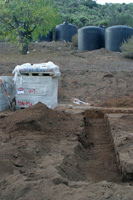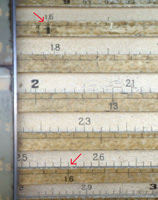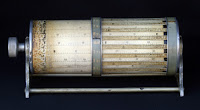


Before slide rules were developed, there were several other instruments based on the same general principle. One of these was the “sector rule", and the scans at right show a particularly beautiful example of that instrument. This one was made around 1785 by the firm of Nairne & Blunt, in London, England. It is made of narwhale ivory and brass; the engravings are all made by hand. Highly skilled craftsmen were needed to make these devices.
The top picture shows the front of the sector rule, with its hinge on the left. The middle picture shows the back, and the bottom picture shows the front of the sector rule when it is completely unfolded.
Sector rules were used for several purposes. For simple multiplication and division, the rule was completely unfolded, as seen in the bottom scan. Such computations were made with a pair of dividers, using the Gunter’s line (the bottom scale in the bottom scan). For constructing angles, or measuring angles, the rule could be folded to the desired angle, and then some simple geometric rules and a pair of dividers would do the rest. For general trigonometry, other scales would let you find sines, cosines, and tangents — and their inverses. Finally, another scale would let you find the log of a number, or its inverse.
All of this computational power was contained in a sector rule just like this one, and a pair of dividers. The rest was supplied with just a bit of mathematics knowledge, and considerable dexterity. The latter requirement is probably the major drawback of the sector rule — they were not easy to use! In my practice sessions, I’ve often wished I had four or five extra hands. Slide rules, through their innovations of the slide and the cursor, make these same computations, using the same general principle of a logarithmic scale, vastly more convenient.
Given their age (as much as 400 years old), there are a surprising number of surviving sector rules. Often they appear to be basically unused, as this one does (on a well-used sector rule, you’ll see dings and scratches from the sharp points of the dividers). I’ve read speculation, based on the preceding observation, that sector rules were the “gentleman’s gadget” of their era — purchased more as a fashion accessory than as a genuinely useful tool. Given the challenges of using them, I’m inclined to give credence to that notion. Nonetheless, I’m attracted to the beauty and elegance of these old instruments, and fascinated by the computations that can be performed with them…




















